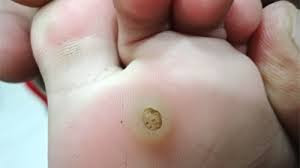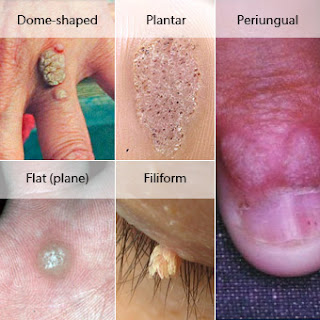There are five main types of warts. The warts that we have across our body all have distinct appearances. Learn more about the types of warts so you know which one you have.
Common Warts
 These are grainy skin growths, usually small that occurs on the fingers than the hands. Common warts are rough to touch, they also have a pattern of tiny black dots (called seeds). These 'seeds' are small, clotted blood vessels.
These are grainy skin growths, usually small that occurs on the fingers than the hands. Common warts are rough to touch, they also have a pattern of tiny black dots (called seeds). These 'seeds' are small, clotted blood vessels.Common warts are transmitted by touch and the virus is very contagious. Children are usually more prone to have common warts as their immune system is not well developed. Common warts don't need any treatment as they go away on their own. Most people choose to treat common warts as they find them embarrassing.
Plantar Warts
 These are the ones that appears on the heels or balls of your feet. Plantar warts are usually hard, grainy growths on areas that feels the most pressure. Unfortunately the pressure caused on the feet may also cause the plantar warts to grow inward (under the skin). This make the plantar warts harder to cure.
These are the ones that appears on the heels or balls of your feet. Plantar warts are usually hard, grainy growths on areas that feels the most pressure. Unfortunately the pressure caused on the feet may also cause the plantar warts to grow inward (under the skin). This make the plantar warts harder to cure.Most plantar warts, like other warts do not require treatment as they go away on their own with time. Unlike other types of warts, plantar warts can be more painful and cause discomfort.
Flat Warts
 They are called flat warts because they do not pop out of the skin like other types of warts and usually spread over a larger skin surface. Flat warts are slightly elevated above the skin. There no need at all to worry about flat warts, they are referred to as juvenile warts since they occur in childhood and adolescence. They disappear without any medication and don't come back.
They are called flat warts because they do not pop out of the skin like other types of warts and usually spread over a larger skin surface. Flat warts are slightly elevated above the skin. There no need at all to worry about flat warts, they are referred to as juvenile warts since they occur in childhood and adolescence. They disappear without any medication and don't come back.Flat warts are most likely to appear on the face, neck, legs, hands and fingers. Both sexes have them. The flat warts don't appear on the plantar and palm.
Filiform Warts
 Filiform wart is the most embarrassing of all types of warts. These are long, thin, flesh colored warts that usually grow on the face. Filiform warts can grow anywhere on the face but are most common on the eyelids, neck and lips. The wart is caused by the human papiloma virus (HPV) causes the top layer skin to grow rapidly. The filiform wart is highly contagious but go away pretty fast once taken care of.
Filiform wart is the most embarrassing of all types of warts. These are long, thin, flesh colored warts that usually grow on the face. Filiform warts can grow anywhere on the face but are most common on the eyelids, neck and lips. The wart is caused by the human papiloma virus (HPV) causes the top layer skin to grow rapidly. The filiform wart is highly contagious but go away pretty fast once taken care of.The main reason anyone who has the filiform type of wart gets it treated is because of its unattractive appearance. The wart is benign and painless.
Periungual Warts
 This type of wart grows in cluster around the fingernails pr toenails. Usually grows like a cauliflower-like skin around the nail plate. Loss of cuticle is often what follows whe you have periungual warts. One way to avoid periungual is to stop nail biting as nail biting increases the risk of having these warts.
This type of wart grows in cluster around the fingernails pr toenails. Usually grows like a cauliflower-like skin around the nail plate. Loss of cuticle is often what follows whe you have periungual warts. One way to avoid periungual is to stop nail biting as nail biting increases the risk of having these warts.Peruingual Warts often cause damage to the nail. Since the wart sometimes grows below the nail, it'll either lift the nail from the skin or cause it to detach. This wart sometimes cause pain when the wart extend to under the nail. Peruingual Warts can cause permanent deformity to the nail.
Updated on: 11 June 2020









